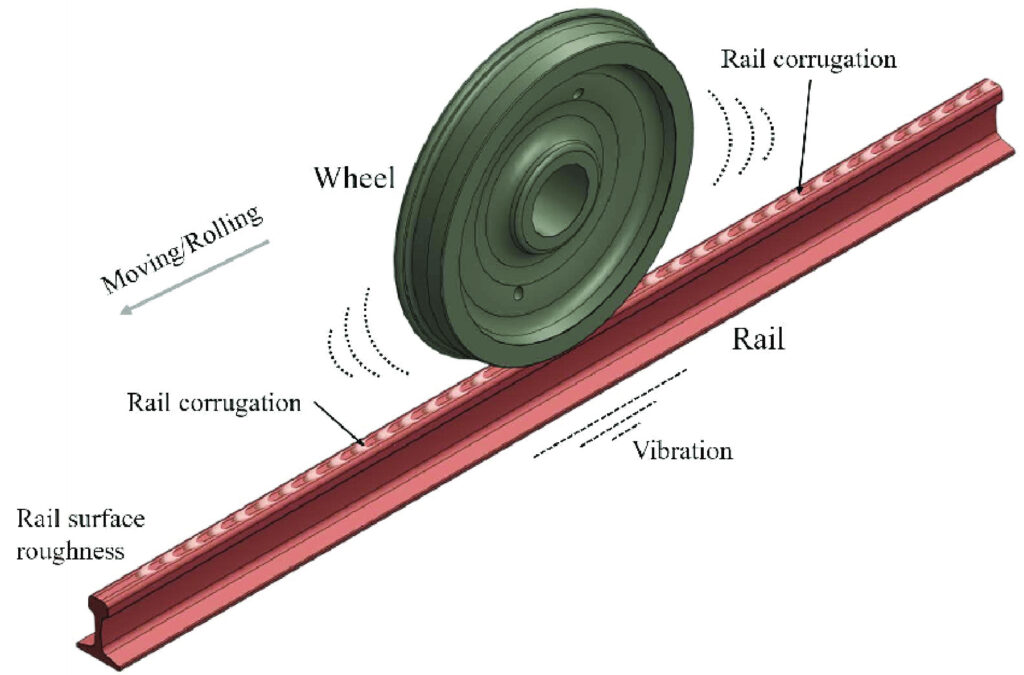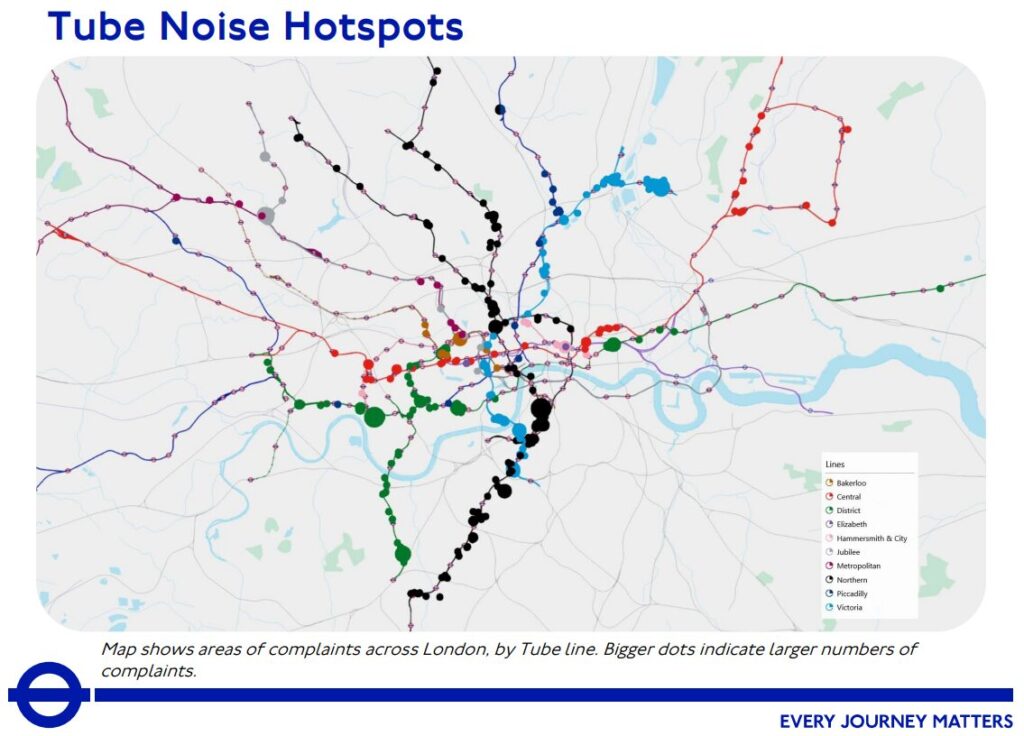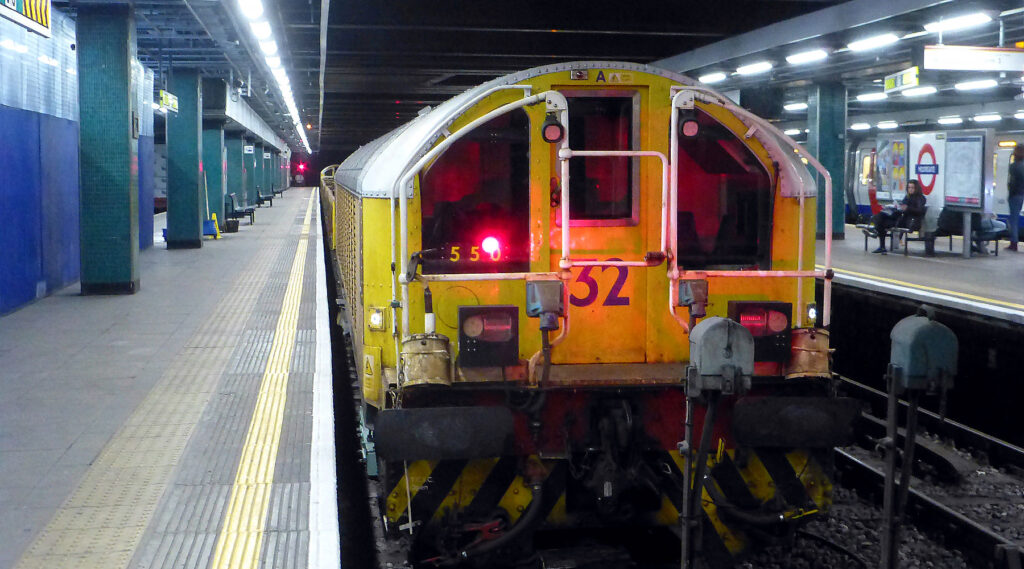Transport for London (TfL) is exploring new ideas to reduce screeching noise from trains inside tube tunnels.
Most of the noise comes from wear and tear on the top of the rail where the surface becomes affected by a type of track wear caused by repeated acceleration and braking, called rail corrugation. Once this process has started, it will worsen exponentially as time progresses.

Jeong, Wootae. (2021). Spectral Characteristics of Rail Surface by Measuring the Growth of Rail Corrugation. Applied Sciences. 11. 9568. 10.3390/app11209568. CC BY 4.0 Deed
Noise on the London Underground has worsened in recent years thanks to the introduction of automatic train operation, which can allow trains to run more reliably and closer together but also means there is more acceleration and braking by the automatic system, and that increases rail corrugation on the tracks.
There is less corrugation on manually driven trains with more speed variation (Bakerloo and Piccadilly lines), as this map shows.
The solution, other than eventually replacing the track, is to run an engineering train over the track and regrind the surface of the rail to create a new smooth surface.
TfL currently spends around £7-10m a year on rail grinding (for both critical maintenance needs and noise reduction), so it’s already a significant part of the annual maintenance bill. However, there’s only so much track that can be fixed, and the problems can build up to create very noisy trips which are uncomfortable for passengers, not to mention the staff who drive the trains.
Last June, TfL’s Commissioner, Andy Lord, said an international innovation competition was being set up to look for novel solutions to reduce track noise in addition to their routine rail grinding. In a written reply to Caroline Pidgeon AM, the Mayor of London, Sadiq Khan, recently said that TfL’s Open Innovation team is working on the market research questionnaire to send to the industry for feedback.
TfL is also planning other trials which could reduce noise levels.
Ideas include using tuned mass dampers (absorptive materials that would be fixed to a tunnel wall), which TfL hopes will reduce airborne noise levels and slow the corrugation rate on rails.
TfL is also undertaking a Variable Speed Trial on the Northern line between Tufnell Park and Kentish Town, to determine if this slows down corrugation without negatively impacting service levels.
A similar trial took place last year on the Jubilee line around Canning Town, and while slower trains did reduce track noise, it would affect the timetable if maintained, so trains had to resume normal speeds again. To help reduce noise affecting residential housing around the station, TfL is working on fitting sound-absorbent materials around the tube tunnel entrance, which should be in place by this spring.
Noise on the Victoria line between Finsbury Park and Seven Sisters was highlighted for attention but was delayed due to work elsewhere on the line last year and being considered for rail grinding this spring. TfL is also making a spot check on the tracks in the South Wimbledon area where rail grinding last September appears to have not fixed all the problems.
TfL is also in the process of removing some track fastenings added a few years back, which, while they reduce track noise affecting residential homes near the railways, perversely seem to increase it inside the trains themselves by speeding up the incidence of rail corrugation on the tracks. Unfortunately, replacing all the track fastenings will cost around £60 million.
However, on a network as extensive and varied as the London Underground, no one solution will fix everything, and rail noise is an inevitable side effect of running trains over the tracks. The best solution is spending more money on maintenance, which will always be a challenge, and even more so in the post-pandemic financial times.









What happened to the case of the professional oboist who was suing TFL for hearing damage ?
Probably an advantage if they had to sit next to the violas 😉
The map is very interesting though I’m rather dubious about the data behind it. It wouldn’t be difficult for someone to measure the actual noise levels. My watch alerted me yesterday to excessive noise levels between Stratford and Leyton on the Central line yet it seems nobody complains about it. Conversely, there seem to be lots of complaints about the relatively quiet section up to Woodford. Nobody seems to be complaining about noise in the Jubilee line extension tunnels either!
I was also surprised to see zilch between Stratford and Leyton – going eastbound is something else. Weird.
Yes pretty but rather dubious data/representation – ie just the number of noise complaints made ( over what time period?, type of complaint, Resloved or open ? etc etc)
It’s interesting that this story popped into my feed after the trip I made at the weekend. Whilst travelling on the Northern Line between Tottenham Court Road and Archway, the conversation between me and my partner was interrupted several times because, even shouting in each other’s ears, we couldn’t make ourselves understood.
I do hope the drivers use hearing protection, because working in that environment for extended periods must litteraly be deafening.
The Victoria line between Vauxhall and Stockwell is painful because of track noise. But it’s been like that for years.
What suprises me is that the loudest part of the bank branch of Northern Line seems to be the newest bit (the new tunnel at Bank) where it suddenly gets horrifically loud. Not sure what happened there..
Yes – completely agree. Likewise, when going towards Battersea from Kennington. Something has gone very wrong with these upgrades from a noise perspective, cannot be due to wear and tear.
What about alternative braking systems? A combination of inductive braking and replaceable brake pads that contact the rail directly might be worth trialling.
I always enjoyed the Paris Metro, which seems to run on rubber tyres
Lines 1, 4, 6, 11 and 14 (and the ones under construction) run on rubber tyres. The other lines run on “classic” wheels.
I’m sure the noise between Seven Sisters and Finsbury Park is about tunnel linings made differently. There’s a point where the noise changes suddenly coming into Finsbury Park (drowning out the “We are now approaching Finsbury Park” announcement). I don’t think that can be rails.
Victoria line is getting much worse and vibrates my house a lot
Ear defenders.
why not get away from wheels altogether and run on magnets its been done and with London underground the tec is there already cabling etc You will always get a lot of noise with steel on steel
For the same reason pretty much no other railway has made the transistion – it’s too expensive and not suitable for metro railways anyway.
The number of complaints is probably affected by the number of passengers on the route as much as by the noise level.
“There is less corrugation on manually driven trains with more speed variation”
So program the automatic system to mimic a human.
Why not invert the sound of the screech and play it back when the noise goes above a certain level. Noise cancelling.
I complained a few years ago about the incredible screeching inside St Pancras rail station (Thameslink). The reply said they deliberately allow more energy to be dissipated on the corners via screeching so as to reduce the noise conducted to St Pancras Hotel above.
Ah, slightly different to corrugation, this is due to a small radius curve in the track, causing the flanges of the wheels the scrape noisily against the side of the rails. Network Rail uses flange lubricators, typically applied via the rails themselves, although grease can also be applied from a train. I’m not quite sure how eliminating the screeching would help the hotel: perhaps the high frequency sounds would be converted into a lower frequency which would permeate solid material more easily…
Check out Paris metro
The noise is unbelievable between Redbridge and Leytonstone for years and years.
And from Liverpool Street to Leyton, parts of the line make your eardrums vibrate
Is it something to do with the modern trains, I used to travel on the tube daily 50 years ago and never noticed excessive noise? Maybe I just accepted that trains make a noise when they were moving.
I can’t believe people are complaining about the quiet Metropolitan line north of Baker St, much of it above ground, but not about the yowling Jubilee line? Have the map people transposed the colours?
I really don’t get why ATO trains are worse for this – why would a computer need to brake or accelerate more often than whatever the line demands? As for “tuned mass dampers (absorptive materials that would be fixed to a tunnel wall)”- TMDs are most often found in buildings, to stop swaying. The Wiki article suggests a possible application to trains but doesn’t mention any example: https://en.wikipedia.org/wiki/Tuned_mass_damper
Fair point. I think the issue may be that ATO* trains: (ATO = automatic train operation, i.e. computer-driven trains)
1. accelerate and brake in the same or very similar locations, so the stress is concentrated on one area of track. Human drivers vary.
2. often accelerate and brake sharper than a human. For example, a human might be cautious and slow down before seeing signals in case there’s a red. The computer knows exactly where the next train/station is so can brake later and harder.
You can sense no.2 by comparing how trains enter stations.
Human drivers (e.g. Piccadilly line) tend to reduce speed earlier when stopping at a station, drive slower for part of the platform, then stop.
Whereas on an ATO line (e.g. Jubilee line) the train enters the station quite fast then applies a heavy brake to stop exactly in the right place.
While the ATO system can be reprogrammed, it takes a lot of time and safety testing. Hope this isn’t too technical.
Source for no.1 is this thread: https://districtdavesforum.co.uk/post/524898/thread
“replacing all the track fastenings will cost around £60 million.”
Breathtaking expense, no? That’s HS2 territory – nearing military levels of so-much-for-so-little
Noise on the Underground is a many-splendoured thing, from the screeching of fixed trucks on most (all?) of the cars on corners, the flat-spotted wheels to the weird high-frequency shrillness of the under-Thames bit of the Jubilee Line
I wonder why no one ever tried rubber? Too French?
Automatic operation is harsher on the infrastructure. In the old days, drivers would coast a lot, especially on down-hill runs like Archway to Euston. These days, the trains constantly adjust the speed using the motors. On said run, I notice how often the motors power up, then break a bit, then power up again every few seconds, making for quite an irritating ride (in addition to the insufferable racket), whereas a diver wouldn’t bother and just coast at the optimum speed. The ATO should have a wider margin of tolerance between stations.